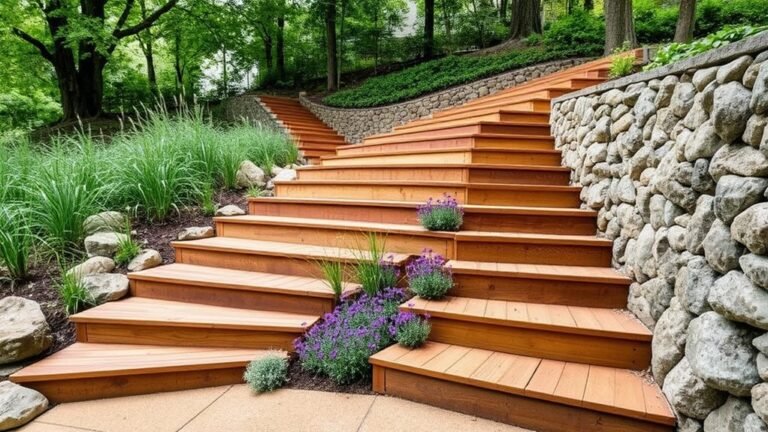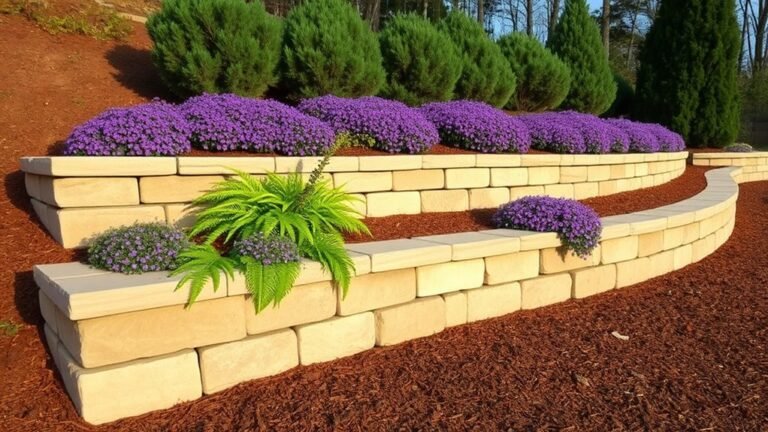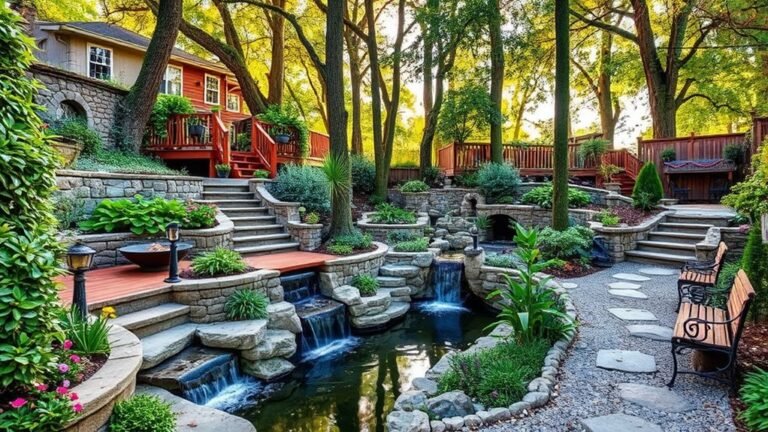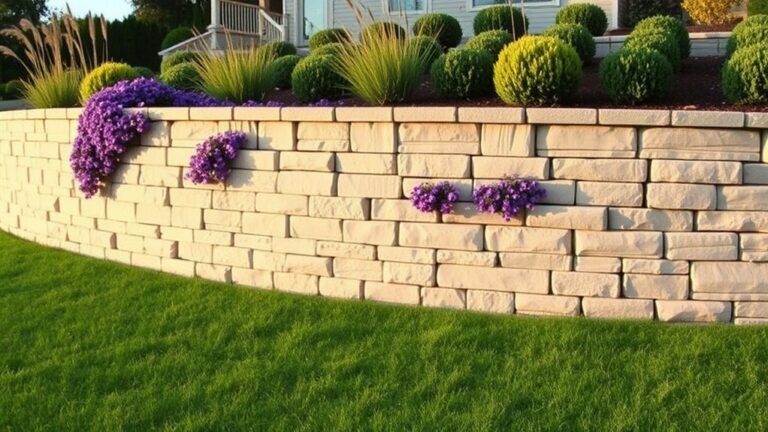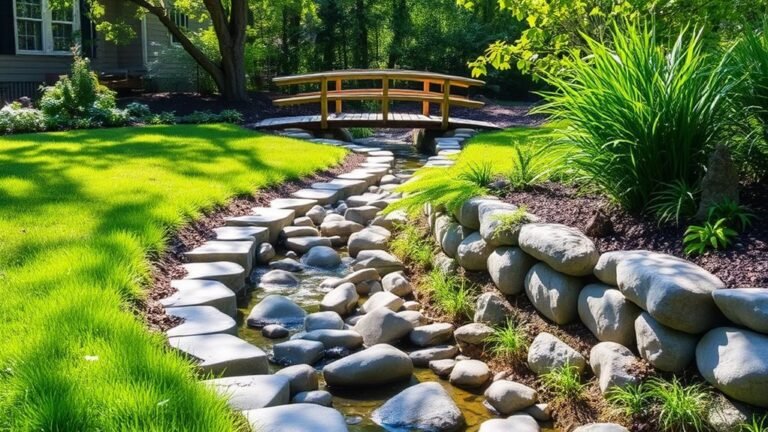18 Backyard Drainage Ideas to Solve Water Issues
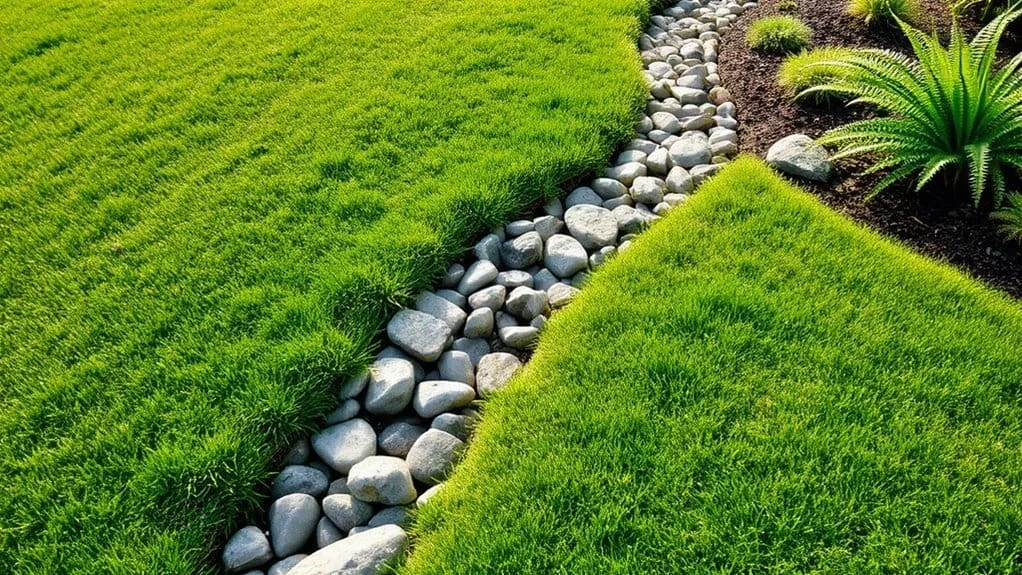
Improper drainage can cause numerous issues, including foundation damage and mold growth in your home. When stormwater accumulates in your backyard, it creates both an unsightly situation and long-term costly problems.
Fortunately, there are effective strategies to manage water in your yard. By exploring various drainage solutions, you can transform your outdoor space while addressing these frustrating water issues.
French Drains
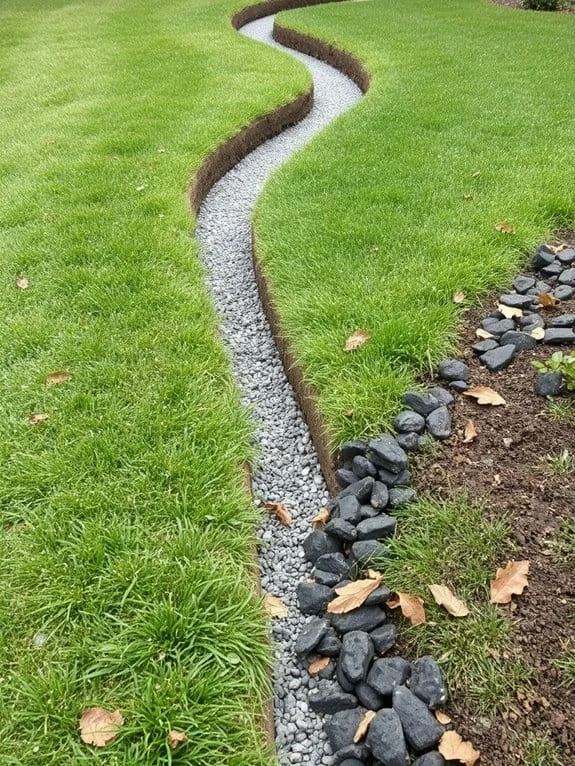
When heavy rain is forecasted, installing a French drain can prevent water pooling in your yard. This effective system directs excess water away from your home by using a trench filled with gravel and a perforated pipe.
To install, dig a gently sloped trench away from your house—a crucial step for foundation protection. Fill it with gravel, place the pipe, and cover it up.
With this simple setup, you'll eliminate puddles and swampy areas, resulting in a drier, healthier yard that your plants will appreciate. Transform your garden into a neighborhood envy with this quick, hands-on solution!
Dry Wells
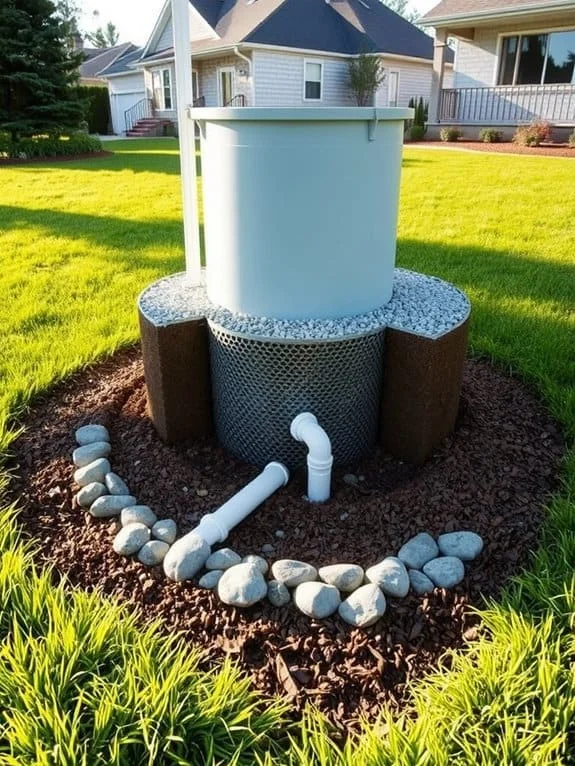
If you're seeking a solution for excess water in your yard, consider installing a dry well. This system improves drainage by providing an area for water to go, preventing pooling. Think of it as an underground sponge that absorbs extra water and allows it to gradually seep into the ground, benefiting your plants.
To set it up, dig a hole and fill it with gravel or crushed stone, ensuring there's a way for water to enter, such as a pipe from a downspout. It's like a hidden superhero working below your lawn, eliminating muddy patches before your barbecue.
However, dry wells work best in well-draining soil, so check your soil type first. While they effectively manage rainwater, they may not resolve every water problem.
With some effort, you can create a dry well that enhances your yard's health and aesthetics, making it the envy of the neighborhood!
Rain Gardens
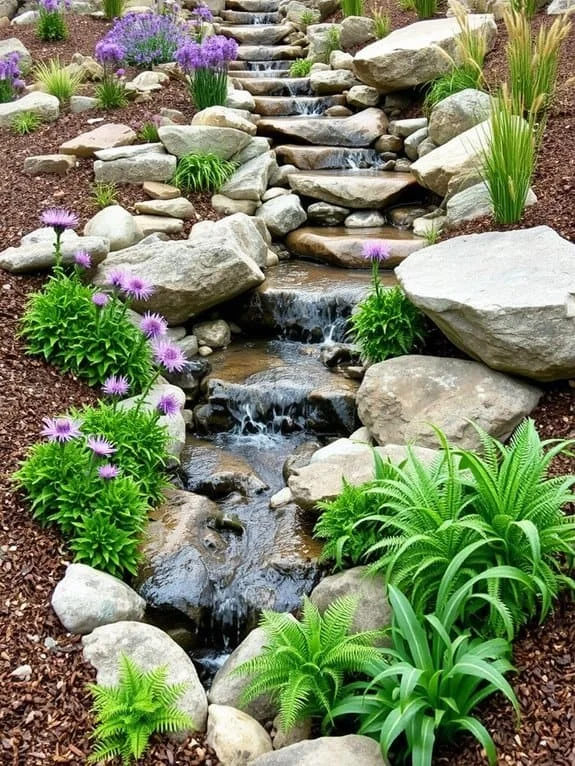
Many homeowners face drainage issues, but a rain garden offers a beautiful and functional solution. Transform a soggy area of your yard into a vibrant oasis with a rain garden that captures and absorbs rainwater.
Select a low spot where water flows, dig a shallow depression, and plant native flowers, grasses, and shrubs that thrive in wet conditions. These plants not only absorb water but also attract butterflies and bees, creating a tiny wildlife haven.
Rain gardens are easy to maintain with regular care. Plus, they enhance your yard's appearance and help filter pollutants, preventing water pollution.
Who knew solving drainage problems could be such a rewarding and enjoyable project? Get gardening and let your rain garden shine!
Permeable Pavers
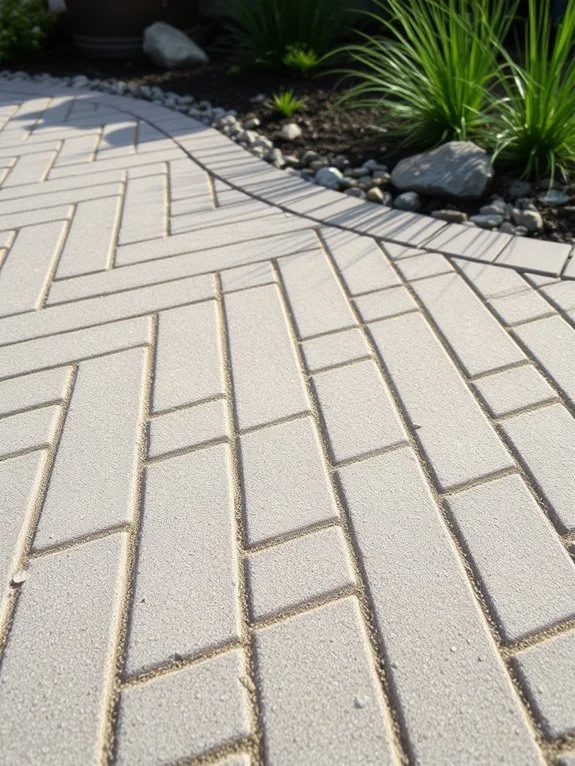
As you consider options for effective backyard drainage, permeable pavers are an excellent choice, allowing rainwater to seep through and recharge groundwater. They prevent ponding and flooding while enhancing your yard's aesthetic. Installing them is simple, with various styles and colors available to suit any backyard theme, whether chic, modern, or rustic. This helps eliminate muddy spots and soggy lawns. Maintenance is easy—just a bit of sweeping and occasional power washing keeps them looking great and functioning well. Your friends will marvel at how your backyard stays pristine, even after heavy rains. Additionally, interlocking tiles are versatile for various outdoor spaces and can be customized for unique layouts.
Swales
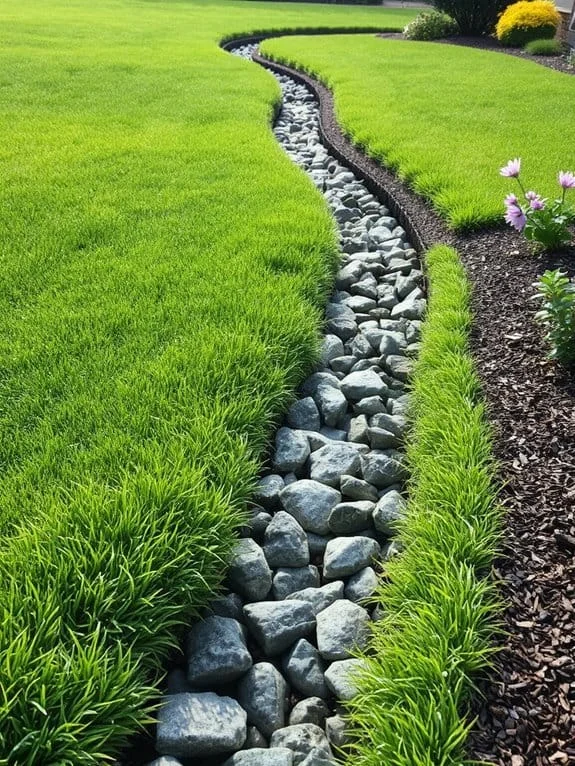
Swales are an effective and natural solution for managing drainage in your backyard. These gentle ditches redirect water away from problem areas, acting as drainage superheroes!
To create a swale, dig a shallow channel along your yard's slope and fill it with native plants, grasses, or colorful flowers. This enhances your yard's beauty while helping to absorb water, filter it naturally, and allow it to soak into the ground instead of running off.
Swales can also manage heavy rain by slowing down water flow, preventing erosion and flooding, and keeping your backyard safe.
Additionally, they attract wildlife, creating a thriving environment where butterflies and frogs can flourish.
Drainage Ditches
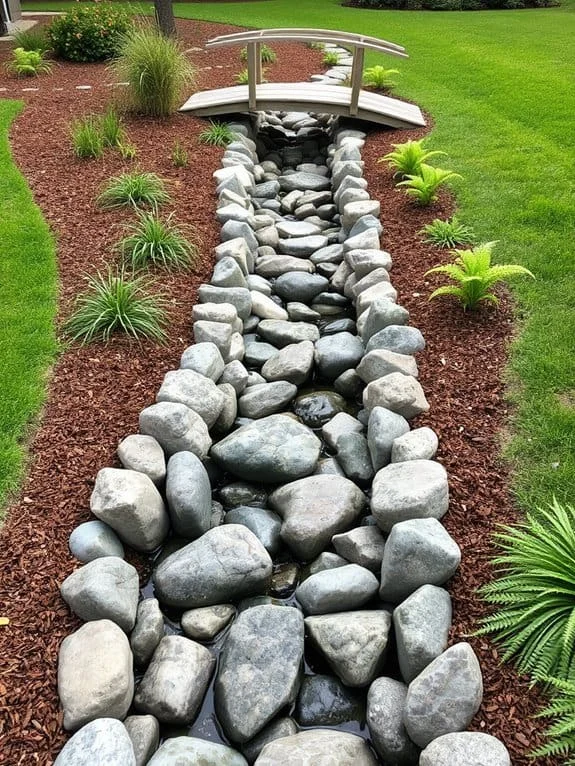
When heavy rain threatens to flood your backyard, drainage ditches effectively channel excess water away from your home. Think of them as the rivers of your yard, guiding rainwater safely!
These shallow, sloped trenches redirect water to a designated area, preventing pooling.
To create a drainage ditch, choose a spot that allows water to flow freely away from your house. Use a shovel to carve a sloped trench toward the endpoint, add gravel for better drainage, and line it with landscaping fabric to keep soil in place while allowing water to pass through.
Planting hardy plants along the edges enhances your yard's beauty and helps absorb excess water.
Just remember to regularly check on the ditch to ensure a clear path. Your yard will appreciate it—less water equals less worry!
Underground Drainage Systems
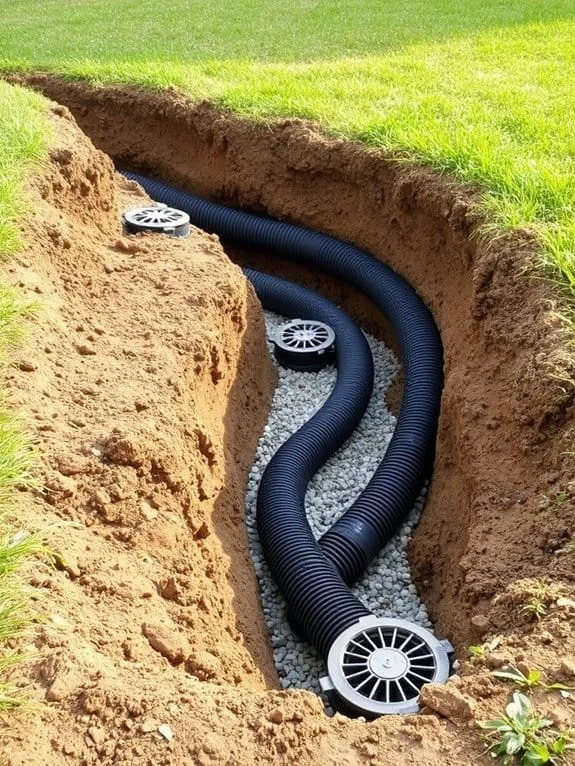
An underground drainage system is an effective way to manage excess water and prevent flooding in your backyard. Instead of water pooling around your garden, a discreet system directs it away from your property, using buried pipes.
Start with perforated pipes that collect water from soggy areas and lead to a dry well or appropriate drainage point, eliminating worries about muddy shoes. These systems can be concealed beneath grass or mulch, maintaining your backyard's aesthetic.
Installing an underground drainage system not only protects your yard but also enhances your property value. It's a practical solution that outshines a backyard lake.
Get started with the installation for a drier, more enjoyable outdoor space that's ready to impress!
Grading the Landscape
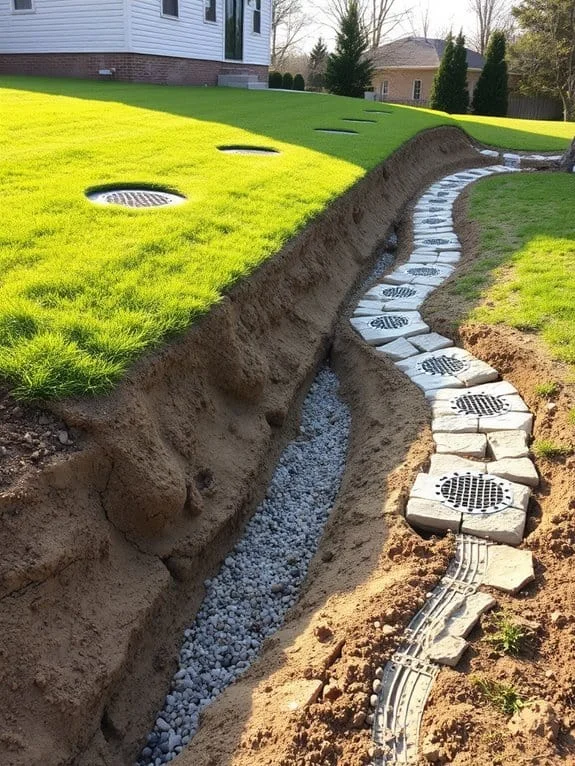
Grading the landscape is crucial for managing water runoff in your backyard. It helps divert water away from your home, preventing puddles and enhancing your outdoor space's appearance.
Here are some tips:
- Create a Slope: Ensure a gentle slope away from your house, ideally about 2% over 10 feet, to prevent pooling.
- Adjust Soil Levels: Add or remove soil as necessary to shape your slopes. This is akin to landscaping yoga—manipulate the dirt to achieve the desired contour.
- Evaluate Drainage: After grading, observe how the area handles rainwater. If water still collects, adjust the slopes further to improve drainage.
Gutter Extensions
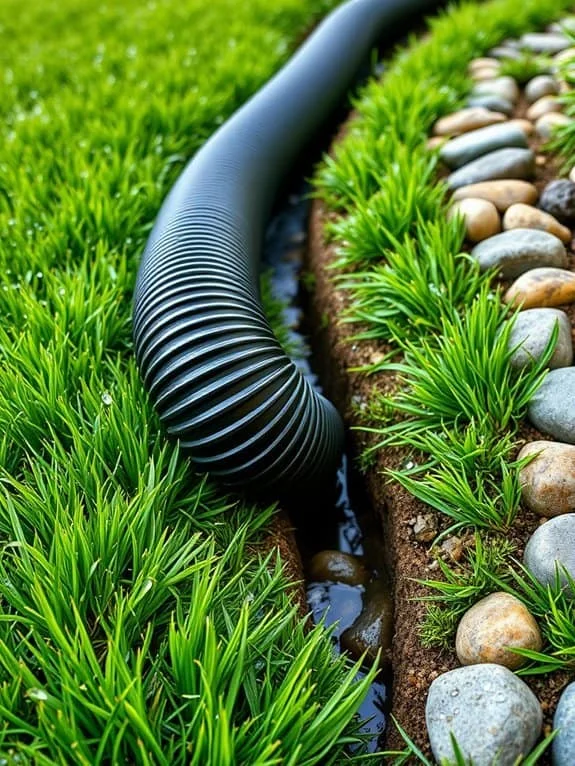
After grading your landscape for improved water runoff, it's crucial to assess your gutters' effectiveness in managing rainfall.
Gutter extensions are essential for directing water away from your foundation and preventing unwanted pooling near your door. These extensions channel water from your downspouts to a drainage system or garden, acting as protective measures for your gutters.
Installation is straightforward, often requiring only clips and some effort.
When selecting gutter extensions, consider the length and material—plastic is lightweight, while metal offers durability. Ensure proper angles to facilitate smooth water flow and prevent pooling.
Regularly clean your gutter extensions to avoid clogs, which can transform them into a breeding ground for critters.
Maintain effective water management by directing it away from your home!
Downspout Diverters
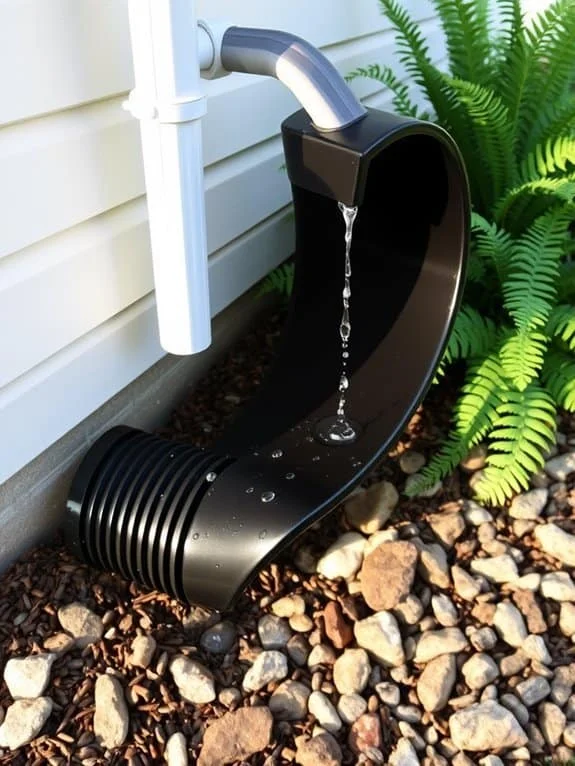
In addition to your gutter extensions, downspout diverters can further enhance your drainage system by directing rainwater away from your foundation and preventing water damage.
They also provide additional options for utilizing collected water.
Here are three creative ways to use downspout diverters:
- Water Your Garden: Redirect rainwater into a rain barrel to nourish your plants and cut down on your water bill.
- Create a Dry River Bed: Channel water into a gravel-lined trench for effective drainage and a charming backyard feature.
- Build a Mini Pond: Direct rainwater into a small pond for a unique landscaping element that may attract frogs.
With downspout diverters, you're on your way to a dry backyard paradise.
Dive in and make it happen!
Sump Pumps
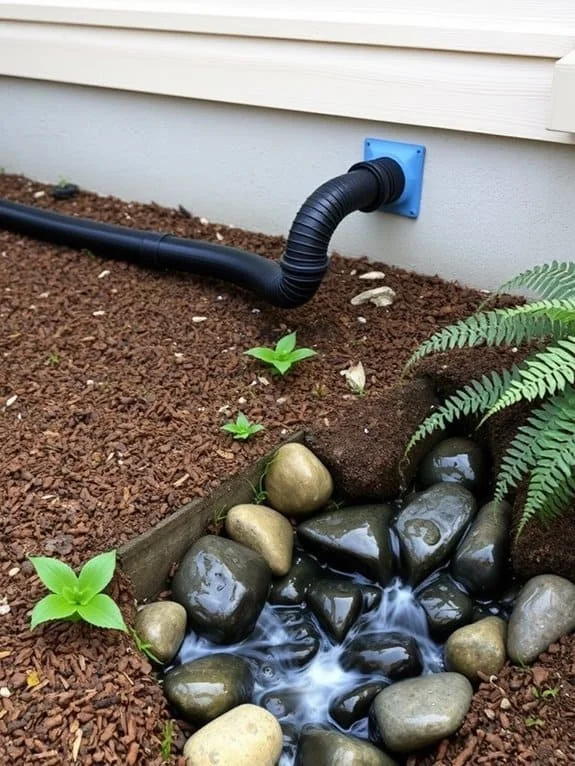
A sump pump serves as your home's first defense against unwanted water accumulation in the basement or crawl space. When it rains or snow melts, water can quickly seep in, but a reliable sump pump will discharge excess water, preventing issues like mold and mildew.
Choose a sump pump suitable for your space; submersible models are effective as they sit directly in water. For severe water issues, opt for a pump with a backup battery to ensure it operates during storms.
Regular maintenance is crucial—test your sump pump periodically and remove any debris around it.
Think of it as a spa day for your pump! A well-functioning sump pump not only protects against water but also restores your home's comfort and peace of mind.
Landscape Fabrics
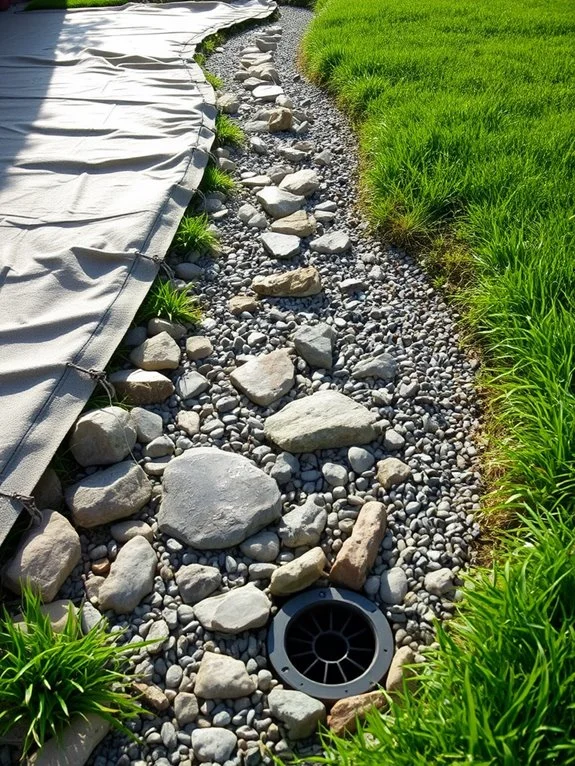
Landscape fabrics, alongside sump pumps, play a vital role in managing water flow in your yard. They filter sediment and prevent weeds, reducing your workload.
Here are three key benefits of using landscape fabrics:
- Improved Drainage: They allow water to flow while preventing soil erosion, ensuring your plants receive necessary moisture without drowning.
- Weed Control: Placed under mulch or gravel, they block weeds, allowing you to spend more time enjoying your yard.
- Soil Retention: Landscape fabrics maintain soil structure and prevent erosion, providing a stable foundation for healthy plant growth.
Retaining Walls
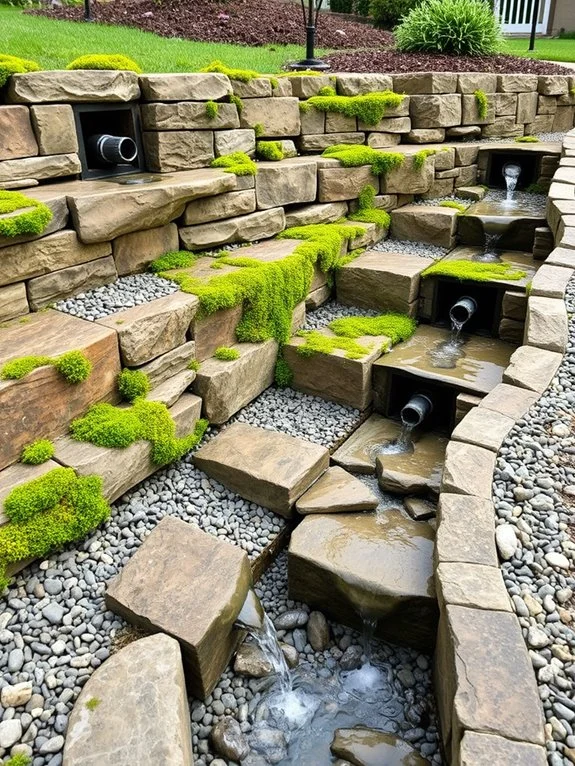
Retaining walls can elevate your backyard by creating levels, managing water runoff, and enhancing landscape design.
They offer a polished look while keeping your yard organized, similar to a fence but with more flair. By leveling sloped areas, you prevent soil erosion and open up new planting opportunities, like a cozy flower bed on a new level.
Additionally, these walls assist with drainage by redirecting water away from your home, avoiding unsightly puddles and soggy shoes.
You have various material options, including stone, wood, or concrete, depending on your style and budget.
Building a retaining wall can also be a fun weekend project, reminiscent of an adult-sized LEGO set.
Garden Paths
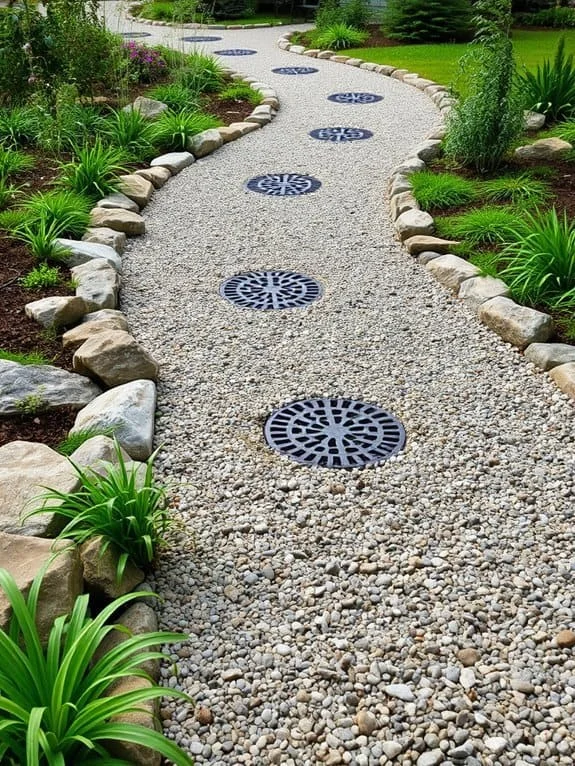
When planning your backyard drainage solutions, think about adding garden paths to improve functionality and aesthetics.
These paths not only provide practical routes through your garden but also enhance its visual appeal. Who doesn't enjoy a charming path to stroll down while admiring their hard work?
Here are three excellent garden path ideas:
- Gravel Paths: Cost-effective and easy to install, gravel paths allow water to seep through, reducing mud. You can also add colorful stones for a unique touch!
- Mulch Walkways: Soft underfoot, these natural paths offer a rustic look and decompose over time, enriching the soil—talk about multitasking!
- Paver Stones: For a polished look, consider paver stones. They can be arranged in interesting patterns, with gaps to facilitate drainage, keeping your garden tidy. Transform your garden by using stylish pavers that can add both beauty and function to your backyard, as highlighted on the Transform Your Backyard With Stylish Pavers website.
Drainage Tiles
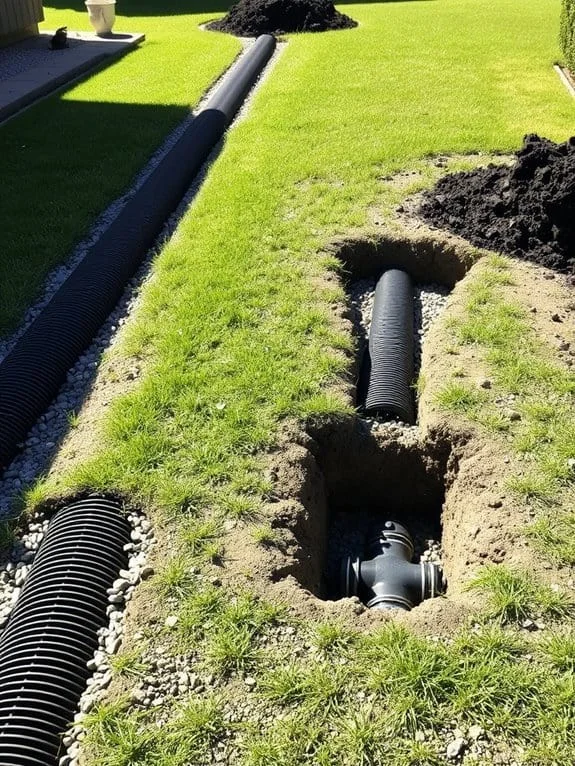
Creating garden paths enhances your backyard's ambiance and effectively directs water flow. If you're dealing with puddles and soggy spots, drainage tiles can be your solution.
These underground tubes collect excess water and channel it away, keeping your yard dry.
Installing drainage tiles is straightforward. Identify areas where water collects, dig a trench, lay the tiles with the perforated side down, and cover them with gravel. It creates a hidden water management system in your yard.
Additionally, drainage tiles help prevent root rot, ensuring your plants thrive. With proper installation, you can enjoy a dry backyard, ideal for barbecues and relaxation.
Soil Amendments
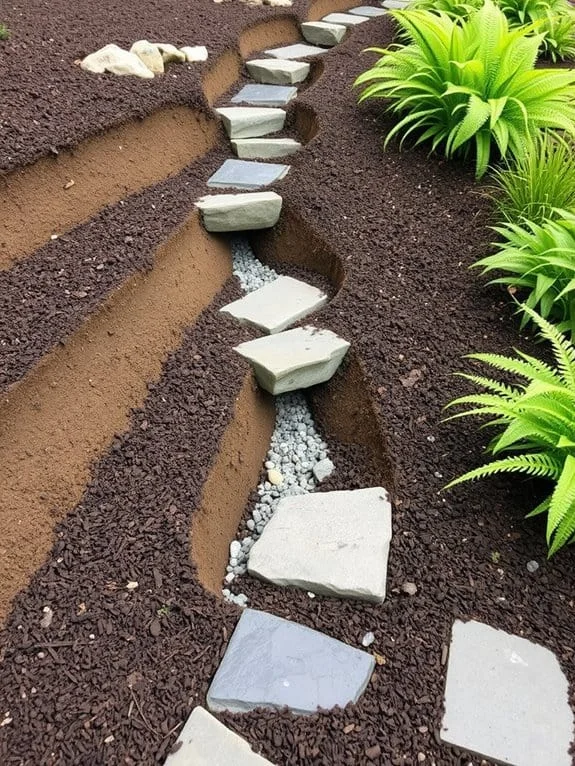
Soil amendments are crucial for improving your backyard's drainage and health.
To eliminate muddy puddles and cultivate thriving plants, incorporating the right amendments is key. Here are three excellent options:
- Compost: This blend of organic material enhances nutrients and improves soil structure, helping it retain moisture while draining excess water.
- Perlite: These tiny white particles boost aeration and drainage, preventing plant overwatering and allowing roots to breathe, which is essential for growth.
- Gypsum: This amendment helps break up heavy clay soil, enhancing aeration and drainage to prevent waterlogging.
Vegetated Swales
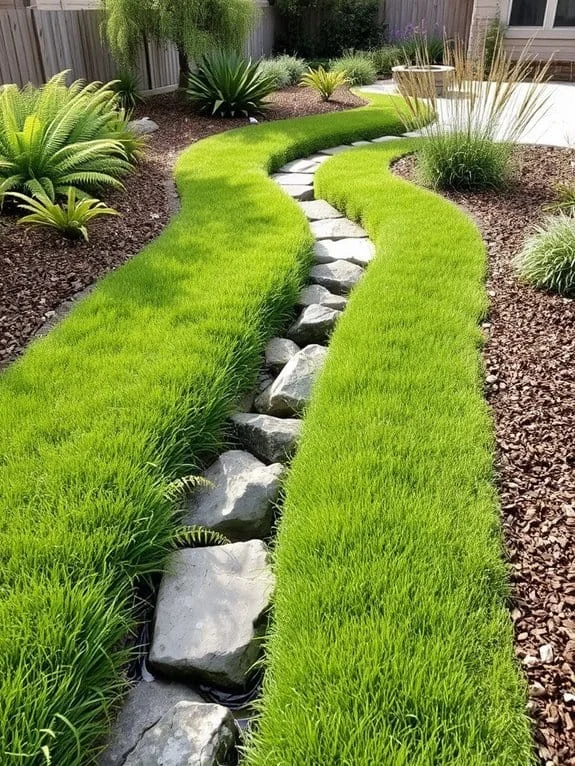
To effectively manage water runoff in your backyard, consider installing vegetated swales. These aesthetically pleasing channels serve a practical purpose by directing water away from problematic areas. Swales are shallow ditches lined with plants that absorb rainwater and enhance your landscape.
To create a swale, dig a shallow, slightly sloped trench and fill it with native plants and grasses suited to your climate. These plants will absorb excess water, filter pollutants, and reduce erosion while attracting local wildlife, including pollinators.
Remember, a vegetated swale doesn't mean sacrificing lawn or garden space; it's a creative method for managing water runoff.
Irrigation Systems
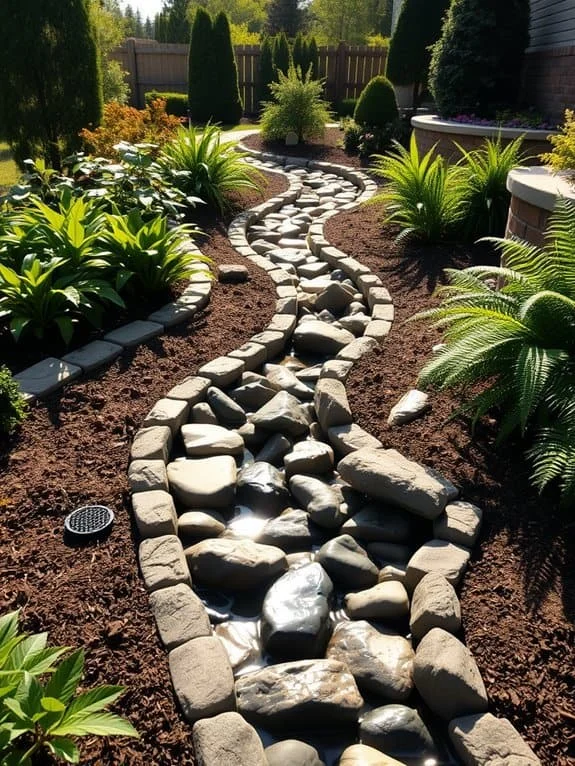
When managing backyard water, consider an efficient irrigation system to create a lush garden and resolve water issues. Your plants will benefit!
Here are three options:
- Drip Irrigation: Delivers water directly to plant roots, reducing waste and being eco-friendly.
- Soaker Hoses: These slowly release water, ensuring even soil saturation. Lay them in your flower beds or vegetable patch and enjoy some relaxation time!
- Sprinkler Systems: Ideal for larger areas, timed sprinklers provide consistent watering. Just remember to check the weather regularly!
An irrigation system not only keeps plants healthy but also saves time and water—truly a win-win!
Frequently Asked Questions
How Do I Identify Drainage Problems in My Backyard?
To identify drainage problems in your backyard, start by observing puddles after rain—if they linger, it's a sign!
Check for soggy spots or areas where grass grows faster—those are trouble zones.
You'll want to examine your downspouts too; if they're channeling water toward your house instead of away, yikes!
Digging a little might reveal compacted soil, which can also create issues.
What Plants Are Best for Drainage Solutions?
When it comes to plants that help with drainage, you've got some great options!
Consider adding sedges or rushes, since they thrive in wet areas and soak up excess moisture.
Ornamental grasses, like switchgrass, also do a fantastic job of absorbing water while looking fabulous in your yard.
And don't forget those lovely daylilies—pretty and useful!
Can I DIY Drainage Solutions, or Should I Hire a Professional?
You absolutely can tackle some drainage solutions yourself!
DIY projects can be fun and rewarding, plus they save you money. Just make sure you've got the right tools, materials, and a solid plan.
If you start feeling overwhelmed or the project seems too tricky, don't hesitate to call in a professional. They've got expertise that can save time and frustration.
How Often Should I Inspect My Drainage System?
You should inspect your drainage system regularly, just like you check your car's oil or your fridge for expired leftovers.
Aim for at least twice a year, especially before and after heavy storms. Look for clogs, leaks, or any signs of wear and tear.
Think of it as a little maintenance pep talk! A little attention now saves you from a big mess later, and hey, your future self will thank you.
What Are the Costs Associated With Backyard Drainage Projects?
When it comes to backyard drainage projects, costs can vary quite a bit!
You might spend anywhere from a couple of hundred to several thousand dollars, depending on what you need—like materials, labor, and design complexity.
Don't forget about permits, which can add to the total!
But hey, an investment now can save you a soggy mess later.
Conclusion
With a variety of drainage solutions at your disposal, it's time to tackle those water issues creatively. Whether you opt for French drains or rain gardens, you can transform your soggy backyard.
Roll up your sleeves and grab a shovel to get started. Soon, those pesky puddles will be a thing of the past, and your dry oasis will be ready for picnics or games.

